The mockingbird is thought of as a symbol of innocence in literature. However, did you know that there are 16 different mockingbird species worldwide? If not, you’ll be fascinated to learn that each mockingbird has unique features.
While some mockingbirds are known for their bright colors, others are known for their ability to mimic the songs of other birds. With most of the mockingbird population residing in the United States and Mexico, most people haven’t had the chance to see their beauty!
Don’t worry! We’ve taken the time to gather all the information you could ever want on the different mockingbirds. Below, we’ll explain how each mockingbird differs from one another and their unique traits. Let’s dive in!
Discover the World of Mockingbirds
To discover the world of mockingbirds, let’s start with understanding the genus. The word genus is a taxonomic rank for biological classification. Mockingbirds are a part of the same animal family but are different species. Below, we’ll explore 16 types of mockingbirds.
1. Northern Mockingbird
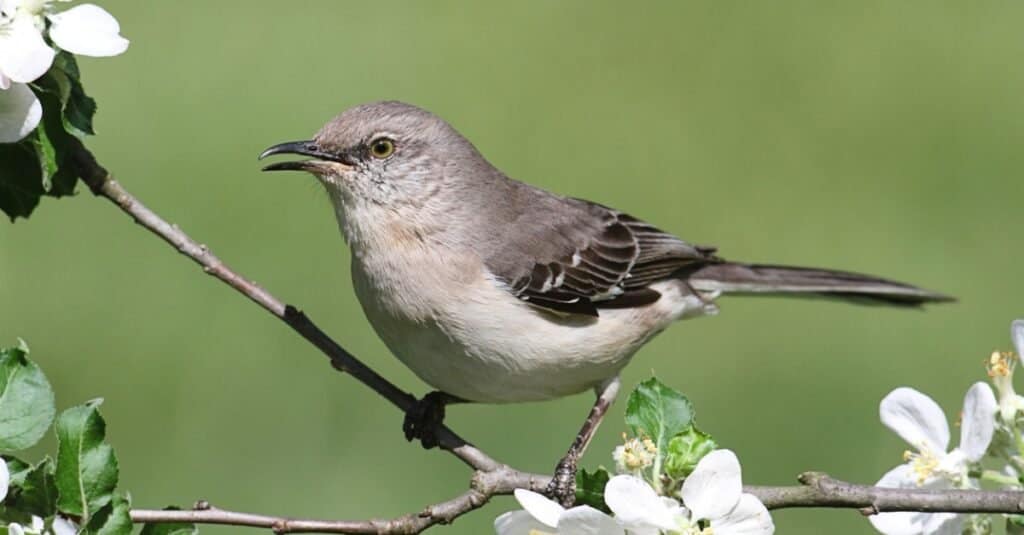
Northern mockingbirds have an uncanny ability to imitate the songs of other birds.
©Steve Byland/Shutterstock.com
The most common out of the bunch is the Northern Mockingbird (Mimus polyglottos). Throughout a male Northern Mockingbird’s life, it can learn over 200 different songs. The species also often flashes its wings and displays them to other animals.
This medium-sized bird is grayish-brown and has white patches on its wings. Aside from that, it also has a longer tail than other mockingbirds. One noticeable feature is its wingspan, which is 13 to 15 inches long.
One of the most distinctive traits of the Northern Mockingbird is that it can mimic the sounds of its environment. You will often hear them mimic the songs of other birds or sounds from their environment.
While being a small breed, the Northern Mockingbird is very territorial. Particularly, the male is known to chase other birds, critters, and even dogs away from their nesting grounds. Their nests are always built inside trees and shrubs, and the female mockingbird will lay three to six eggs per clutch.
2. Discover the World of Mockingbirds: Mockingbird
The Blue Mockingbird (Melanotis caerulescens) is a beautifully deep navy-colored bird. Its feathers have a unique structure that makes the pigment look slightly gray.
The Blue Mockingbird is a smaller version than the Northern, featuring distinctive blue features with black beaks. Its total length spans eight inches, and it weighs a little under one pound.
Being a songbird, the Blue Mockingbird can mimic sounds. Unlike other Mockingbirds, this species can mimic other birds’ songs, human voices, and much more. They are very good at mimicking environmental sounds of the modern world, including digital noises.
Since Mockingbirds are migratory, you can find the Blue Mockingbird in Mexico, South America, and the Southern United States. They are mainly attracted to areas with foliage and trees, as they prefer shade during the hot summer. In addition, they enjoy building their nest low to the ground instead of on trees.
3. Blue-and-white Mockingbird
The Blue-and-white Mockingbird (Melanotis hypogeous) and the Blue Mockingbird are the only species inside its genus. This is mainly due to their dark navy blue coat.
The Blue-and-white Mockingbird is similar to the Blue mockingbird, except it has a distinctive white underbelly. Its main plumage is a dull slate blue, but this bird has a brighter crown. There are also hints of black located on the birds’ wings and tails. However, the most distinctive feature is the black stripe on its face that looks like a mask.
For vocalizations, it creates a medley of notes in rapid succession. It uses monosyllables and shrill squeaks, and much more. This includes whistles, croaking, and other calls. The Blue-and-white Mockingbird is often mistaken for other species due to this.
You can find the Blue-and-white Mockingbird in El Salvador, Guatemala, Honduras, and Mexico. The species isn’t picky regarding nesting grounds, so you can see it in various landscapes. However, it does love pine forests and evergreens.
4. Discover the World of Mockingbirds: The Tropical Mockingbird
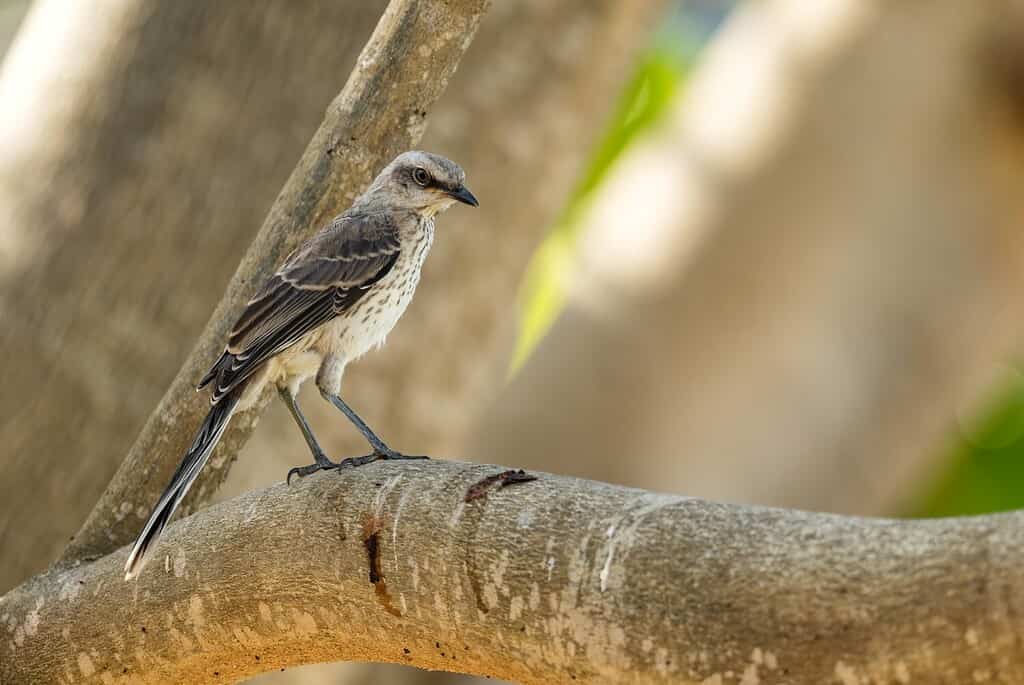
Unlike other Mockingbird species, the Tropical Mockingbird doesn’t sing or mimic.
©David Havel/Shutterstock.com
The Tropical Mockingbird (Mimus gilvus) is another variation of the Mockingbird, except it lives on islands.
The Tropical Mockingbird’s body spans nine inches with long legs and a tail. Distinctive traits are different between the sexes, with males having overall gray coloring with white patches on each wing and rump. On the other hand, females have white markings on their chests and less vibrant colors.
Unlike other Mockingbird species, the Tropical Mockingbird doesn’t sing or mimic. They produce a distinctive sound but do not “sing” or mimic the environment’s sounds. Instead, they have a long sequence of trills and phrases.
You can find the Tropical Mockingbird in specific areas near the equator. This includes parts of Southern Mexico and the Caribbean Islands. They also don’t migrate and generally stay in these countries.
5. Chalk-browed Mockingbird
The Chalk-browed Mockingbird (Mimus Saturninus) is omnivorous and eats insects and small vertebrates. While it still enjoys fruit, its main source of food is other living organisms.
You can identify this Mockingbird as it has a gray crown and nape. The bird features a gradient look, darker feathered on top and less towards its belly. Its undersides, such as the throat, breast, and belly, are all white or cream-colored.
What makes the chalk-browed Mockingbird so interesting is its ability to be very loud. You won’t miss this little bird, as it likes to whistle, gurgle, and even mimic other animals! Its favorite time of day to sing is during sunrise and sunset. So, if you hear any weird noises, it might just be the Chalked-browed Mockingbird.
Unfortunately, you won’t see this species anywhere in the United States. It’s native to South America, mainly in Paraguay, Suriname, and Brazil. The Chalk-browed Mockingbird loves open areas with trees and can be found on farms, pastures, and parks.
6. Discover the World of Mockingbirds: The Galapagos Mockingbird
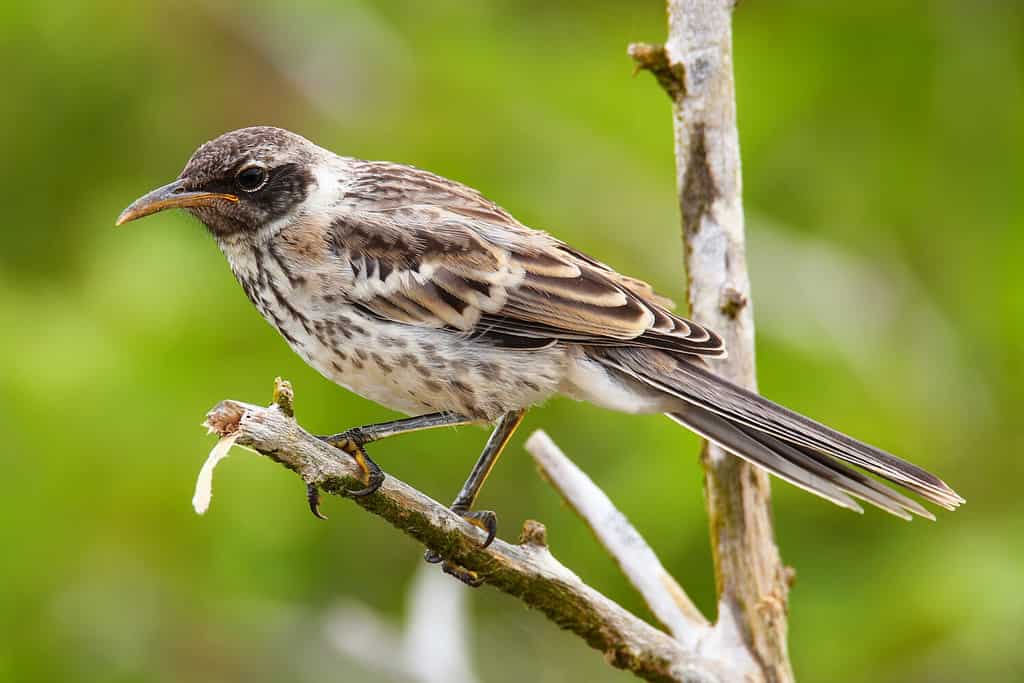
This species is one of the bigger Mockingbirds with long legs and feet.
©Don Mammoser/Shutterstock.com
To understand the world of birds, you’ll want to discover the world of mockingbirds. As the name suggests, the Galapagos Mockingbird (Mimus parvulus) is native to the Galapagos Islands and Ecuador.
This species is one of the bigger Mockingbirds with long legs and feet. This species chases down its prey, which sets its body apart from other Mockingbirds. Due to this, the bird has a unique build featuring a long beak and lower body. Its coat is gray and white patterned but has the classic white underbelly.
The Galapagos Mockingbird sings joyfully and loves to imitate other birds’ sounds. It’s been known to chirp to scare off predators. It can also mimic a wide range of sounds but doesn’t have a big repertoire like other Mockingbirds.
You’ll mainly find the Galapagos Mockingbird in coastal areas with dense forests. They love being in areas where they can blend in and avoid predators.
7. Hood Mockingbird
The Hood Mockingbird (Mimus macdonaldi) is one of the most territorial out of its genus. Unlike other birds, the Hood isn’t afraid of humans and can be found chasing them away.
When it comes to identifying the Hood Mockingbird, it’s quite simple. This species has a unique white marking located on its throat. However, the most noticeable feature that gives this bird its name is its hooded eyes.
Another noticeable trait of the species is that it loves to sing. Out of the Mockingbird types, the Hood Mockingbird is the songstress. It can be found making loud singing sounds throughout the day.
You can only find the Hood Mockingbird on Espanola Island, which is one of the southernmost islands in the Galapagos. The bird rarely leaves or migrates and instead lives comfortably year-round. It loves the dry and wet areas of tropical forests.
8. Floreana Mockingbird
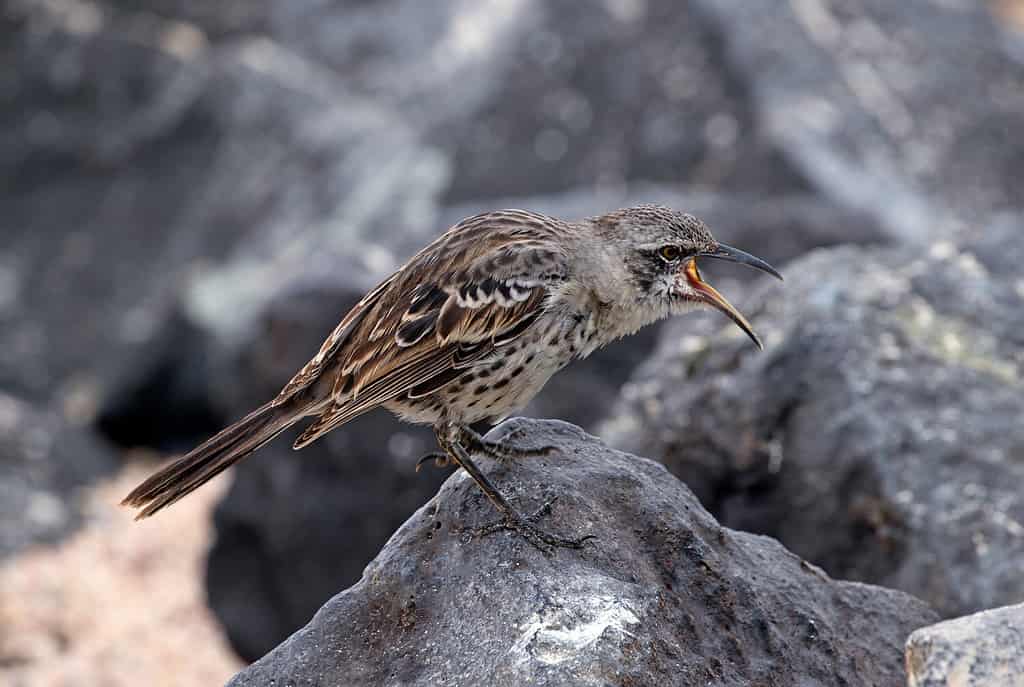
Females of the Floreana species are much more vibrant than the males in coloring.
©gdvcom/Shutterstock.com
To discover the world of mockingbirds, one will need to look hard to find each type of bird. The Floreana Mockingbird (Mimus trifasciatus) mainly has a diet made up of insects. However, due to habitat loss, they are now critically endangered.
Despite other mockingbirds’ dull coloring, the Floreana has exceptionally bright orange plumage with red and black markings. The coloring follows its way down around the wings and the tail. Females of the Floreana species are much more vibrant than the males in coloring.
Its vocal ability is not the same as other Mockingbirds. The Floreana is known for creating intricate songs sung in their territory. They do not mimic other animals or sounds in their environment.
The Floreana Mockingbird is only found on the Galapagos Islands. It doesn’t migrate or move around and is nestled in low vegetation or trees. They are very aggressive and territorial and generally chase out other animals in the area.
9. Bahama Mockingbird
The Bahama Mockingbird (Mimus Gundlach) is sadly extremely endangered. The International Union for Conservation of Nature (IUCN) has already put it on its list.
It’s one of the smallest Mockingbirds with a distinctive gray hue. The Bahama Mockingbird also has a long tail and white patch on its wing. While it’s similar to the Northern Mockingbird, it can be differentiated by its smaller size and dark plumage.
The species originated in the Bahamas but has since migrated to Cuba and Jamaica. A Bahama Mockingbird can nest in low shrubs and bushes and becomes territorial.
10. White-banded Mockingbird

This bird’s distinctive reddish cinnamon and smoky gray plumage are attractive, making it easy to tell apart from other Mockingbird species.
©Foto 4440/Shutterstock.com
The White-banded Mockingbird (Mimus triurus) and the Brown-backed Mockingbird are monotypic and sister species. You can tell that the bird’s coloring is similar to the Brown-backed. However, the main difference is that there are variations for females and males.
The male is a bit larger than the female counterpart. Additionally, they have a gray crown, white underbelly, and a black line through the eye. This bird’s distinctive reddish cinnamon and smoky gray plumage are attractive, making it easy to tell apart from other Mockingbird species.
Out of all the Mockingbird species, the White-banded is the best singer. It has excellent songs and is loud. The bird extends long passages of musical notes and phrases with ease. Aside from that, the bird is also extremely good at mimicking other sounds.
The species can be found mainly in South America. This includes Argentina, Bolivia, Brazil, and a few other countries. They can be found in low woodlands, savannas, and open brush habitats.
11. Socorro Mockingbird
The Socorro Mockingbird (Mimus graysoni) is a rare mockingbird mainly seen in Socorro in the Revillagigedo Islands. Socorro has been affected by deforestation, which has caused the Socorro Mockingbird to lose its habitat. The result of this has led the species to become endangered.
Distinctive markings of the Socorro include gray-brown plumage with a long tail and pointed beak. The males and females are very similar, with the females slightly smaller.
As for singing, the Socorro has different capabilities depending on gender. Males tend to create whistles, while females produce notes. They are less vocal than other Mockingbirds.
The only downside is that they are endangered. This is due to their environment being destroyed and deforested. They are also very brave, leading them to confront prey they wouldn’t win against.
12. Long-tailed Mockingbird
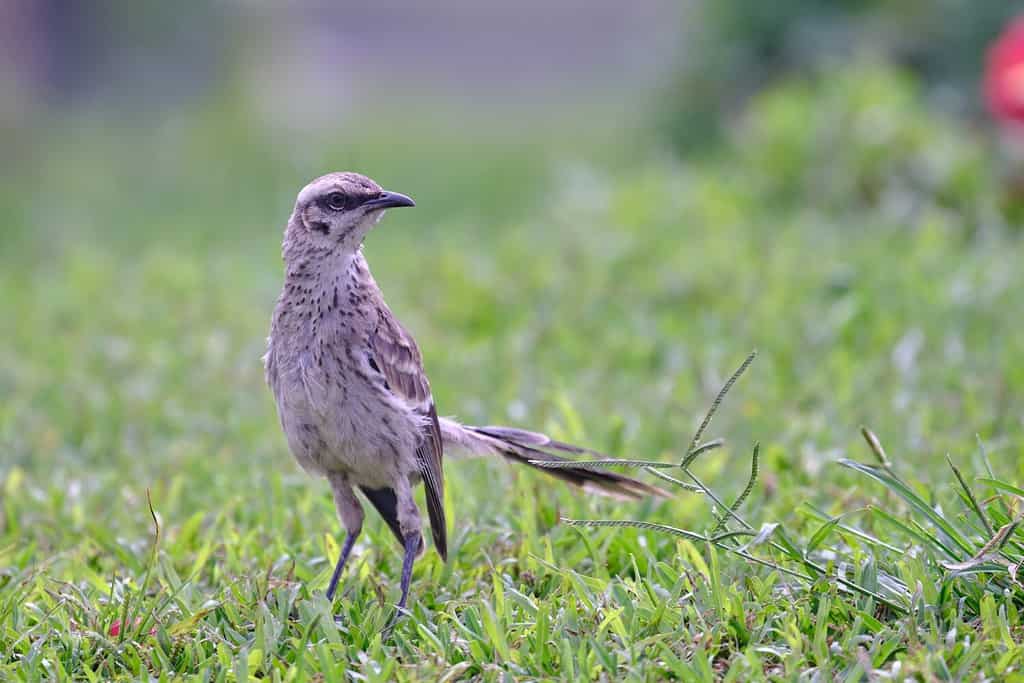
Distinctive characteristics of the species include a fan-shaped tail with white feathers.
©Jonathan Chancasana/Shutterstock.com
As you can imagine, the Long-tailed Mockingbird (Mimus longicaudatus) features a long tail. Distinctive characteristics of the species include a fan-shaped tail with white feathers. It has a broad white supercilium and black stripes around the eyes.
The Long-tailed Mockingbird is one of the most active Mockingbirds and can often be found singing multiple pitches simultaneously. They also love mimicking other animals in the environment but don’t mimic modern sounds.
You won’t see this species in the United States, as they are native to South America, specifically in Peru, Ecuador, and Chile.
13. Patagonian Mockingbird
The Patagonian Mockingbird (Mimus patagonicus) is very social and stays in family groups. While the Patagonian may be its own species, it’s commonly confused with other mockingbirds. If you want to discover the world of mockingbirds, then you should start with the Patagonian.
This is because it has a gray-brown head, back, and chest. However, their lack of a white underbelly is where observers can tell the difference. Other distinctive features include olive-brown wings with altering dark and brown wingtips. Its tail is also a deep brown and features a few white tips on the edges.
As for their vocal ability, this small bird is known for its wide range of noises. Not only does the species enjoy imitating other birds, but also its environment. Locals have reported hearing them mimic car alarms and cell phone chimes.
The Patagonian mockingbird is only found in Chile and Southern Argentina. It loves roaming the trees for fruits and berries. Specifically, it loves mulberries.
14. Chilean Mockingbird

While the Chilean Mockingbird is vocal and has a unique way of doing so.
©Rob Jansen/Shutterstock.com
The Chilean Mockingbird (Mimus thenca) is similar to other Mockingbirds of Chile. Still, the main difference is that they thrive on the ground level.
Distinctive features of the Chilean include long forked tails with white supercilium. However, the bird also has an off-brown and gray crown, neck, and back. Their wings and tail feature a small hint of black.
While the Chilean Mockingbird is vocal and has a unique way of doing so. This small bird loves to sing while perched, spreading its wings, and dancing. The dancing works to ward off predators and attract mates.
Even though its name specifies “Chilean,” you can still find this bird roaming around Argentina. You can find these little birds on the ground roosting and feeding and perching on treetops. The Chilean Mockingbird mainly enjoys being around shrubs and bushes, which it uses for nesting.
15. San Cristobal Mockingbird

You can find Cristobals only on the San Cristobal Islands, part of the Galapagos.
©Danita Delimont/Shutterstock.com
The San Cristobal Mockingbird (Mimus melanotis), also known as the Chatham Mockingbird, is related to the family Mimidae. Prior to 2020, the species was endangered. It is now on the International Union for Conservation of Nature (IUCN) ‘s list as “near threatened.”
It’s a medium-sized Mockingbird with a thin strip of white plumage on its head. It also has a black patch around its eyes, which sets it apart from most other Mockingbirds. The bird’s main body is gray and brown, with light and dark streaks. On the tail, it has a few white tips.
While some Mockingbirds have a distinctive tone or pitch, the San Cristobal doesn’t. Instead, it sings a similar melodious song to scare off predators, like other Mockingbirds.
You can find Cristobals only on the San Cristobal Islands, part of the Galapagos. It doesn’t migrate or move around and only stays on the island. It lives and forages on the ground for fruits, berries, and insects.
16. Brown-backed Mockingbird
The Brown-backed Mockingbird (Mimus dorsalis) is closely related to the white-banded mockingbird. Its distinctive features include a well-defined white line around its head, similar to the San Cristobal. To discover the word mockingbirds, one must tell the different species apart.
This species has a black line through the eye and darker cheeks. The bird’s crown is chestnut brown, slightly gradient all the way to its bottom. Its underside is also distinctively white but has some mixes of tinge.
The Brown-backed Mockingbird has a unique sound when it comes to being vocal. Instead of being harmonious and melodic, the vocalizations sound like harsh notes and chuckles. This is the only Mockingbird that sounds like this.
Aside from that, the Mockingbird can only be found in Argentina and Bolivia. You won’t find this bird anywhere else because it’s not migratory. Instead, it enjoys brush, shrubbery, and hedges.
Thank you for reading! Have some feedback for us? Contact the AZ Animals editorial team.








